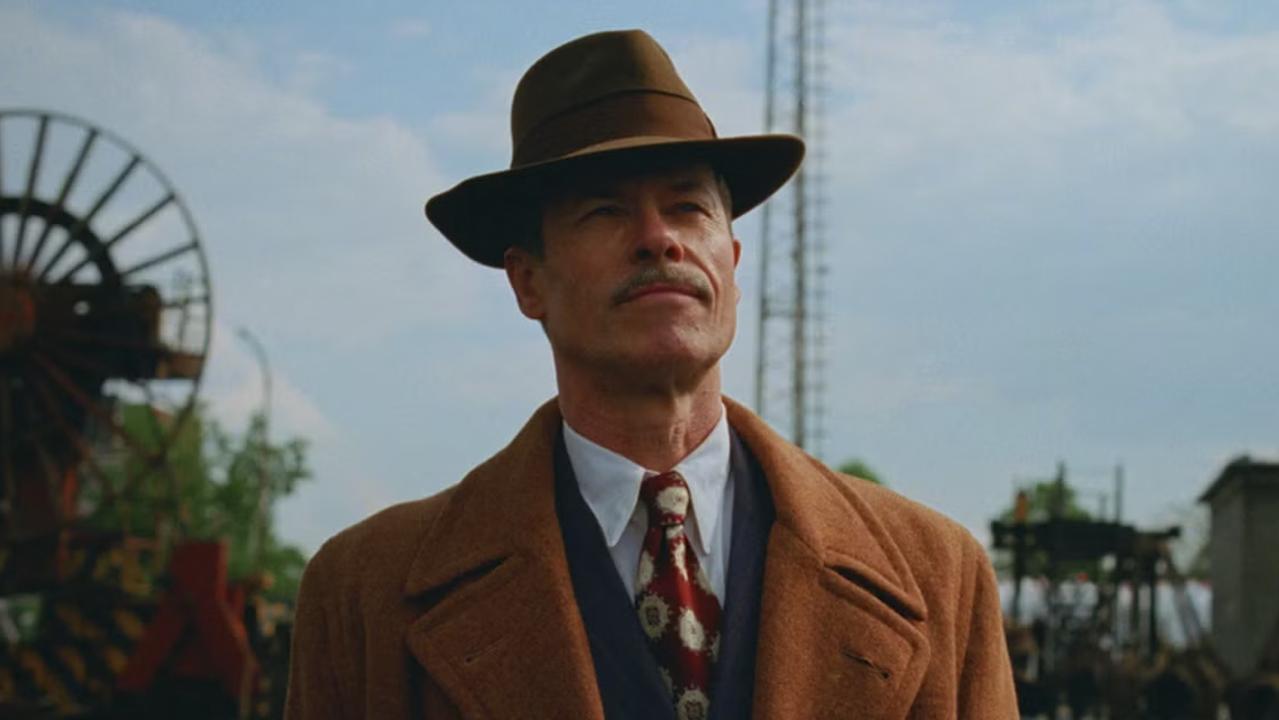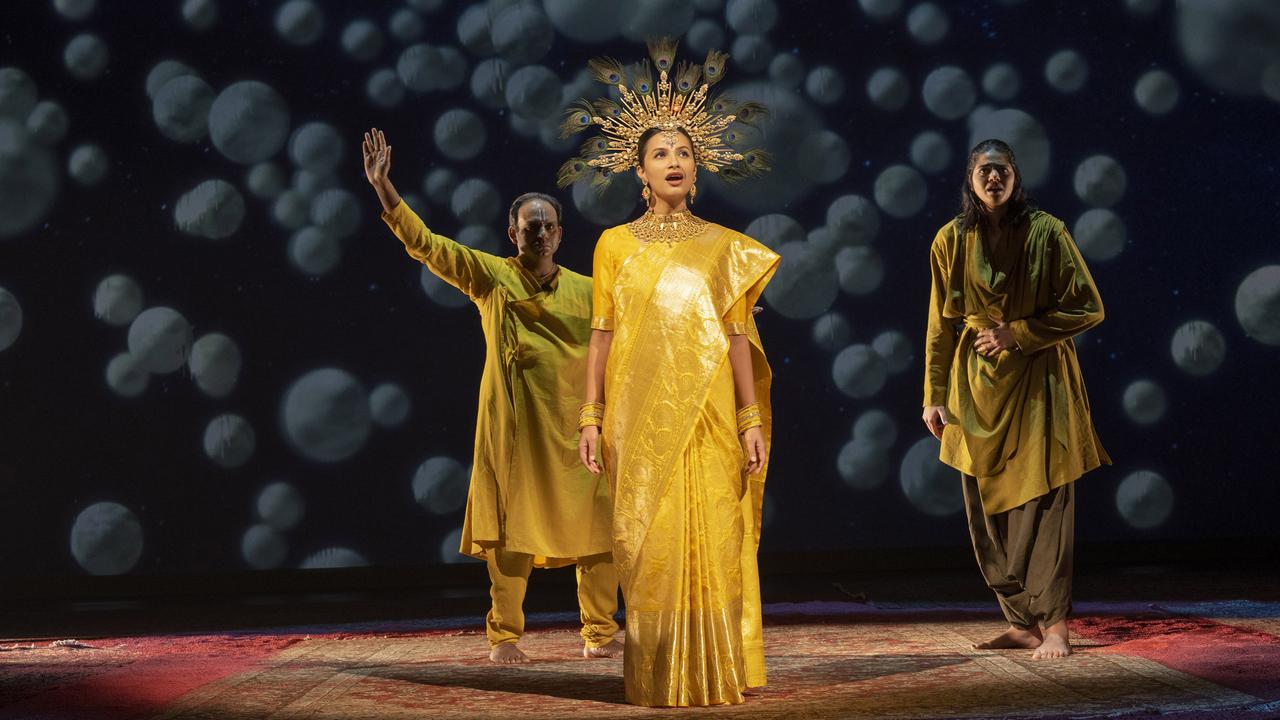Defining nature of a people
IDENTITY and its foundations in the land we inhabit are explored in a provocative exhibition.
VISITORS may well be disconcerted by their initial view of Open Air: Portraits in the Landscape, the first show to be held in the temporary exhibition rooms of the new National Portrait Gallery in Canberra. Andrew Sayers, director of the gallery and curator of the exhibition, would seem to have drawn rather a long bow in assembling objects so diverse in their material forms and cultural origins.
But there is no denying the power of the tribal displays that first confront us, and it is quickly apparent that this is not just another case of lazily hanging contemporary pictures and Aboriginal dot paintings together as though they were about the same sort of thing. Sayers has a specific theme in mind and he is asking us to stand back, as it were, far enough to embrace these strikingly different works within our angle of vision.
The theme of the exhibition is identity and its foundations in the land we inhabit, a concern common to all humanity but that specifically unites the native inhabitants of this country and its European settlers. When our European ancestors arrived here, the land and its flora and fauna were all strange and alien. To make matters worse, early settlement coincided with the romantic movement, at the heart of which was a quasi-religious sense of nature. Whether you think of Jean-Jacques Rousseau lying in his rowing boat and experiencing le sentiment de l'existence, William Wordsworth in the Lake District or Caspar David Friedrich discovering the sublime among forests and mountains, the sense of identity and the experience of nature were more consciously interwoven than ever.
Our forebears left lands of lush green and inexhaustible fertility, rivers, lakes and trees with spreading leafy crowns to arrive in a dry, tired country of marginal farmland and scrawny trees that looked like telegraph poles. To adjust to this new environment was not simply a matter of learning how to farm it efficiently; it was also a long and complex process of aesthetic adjustment. It was necessary to discover the proper beauty of the new land to learn to feel that it was home.
The native inhabitants of Australia are a constant presence in colonial art, alternately heroic and pathetic, but often acting as an unconscious reference point in this search for engagement with the environment. They, of course, had such immemorially ancient connections with the land that they identified themselves with it entirely; not romantically or self-consciously but viscerally.
It is their world that we first encounter in Open Air, in a group of wooden figures and burial poles from the Tiwi Islands. Some of these are quite sophisticated, like the pair Purukuparli and Bima. Others are extraordinarily rudimentary, such as a piece described as a figure or a ceremonial pole, in which the bare outlines of a mask-like face are carved into a painted log. The point, especially when one has just emerged from the portrait gallery's permanent collection of hundreds of individuals, is that these are not portraits in any normal sense of the word.
They are not likenesses, nor do they represent any person the artist has seen; they stand for the ancestors who are supposed to have created the environment in which the tribe exists. The activities of these ancestors in a time of mythical remoteness are evoked in a series of beautiful creation stories painted on bark by Arnhem Land painters Mawalan Marika and his son Wandjuk Marika. These paintings depict the arrival of the legendary ancestors and their travels through the land, and they are divided into compartments that each recall a particular story in the sequence.
Such paintings, similar to the narratives of saints in medieval stained-glass windows, were mnemonics for a people who could not read. The difference is that in the Arnhem Land stories the events in the mythical sequence also serve to map the parts of the land through which, in the footsteps of the ancestors, the tribe will move in its search for sustenance.
So the stories and the land are one; and the ancient stories remain present in the land. When we speak of a mythical past, we are inadvertently assuming a sense of time that does not exist for tribal people.
How can one characterise the difference? As so often, time can best be understood through the analogy of space.
Before the development of perspective in the Renaissance, painters represented figures as overlapping like playing cards or things taking place in the distance as simply above or below the main motif. Similarly, the most natural way to experience time is as a cycle of seasons, repeating itself from year to year, each overlaid on the preceding one. A sense of historical temporality, in which we see particular, non-cyclical events as having occurred at a specific temporal distance from the present, can arise only when a different conception of time and its measurement have developed. It is scarcely imaginable before the rise of complex civilisations whose record-keeping requirements led to the invention of writing.
If the present is a constant replaying of the past, however, the ancestors are always with us and, indeed, ultimately are us. This is the heart of the question of identity in a tribal culture. There is nothing like the sense of the individual that arose in Europe in antiquity, subsided in the Middle Ages and was reawakened in the Renaissance, reaching a kind of climax in the romantic period. One has only to think of the extreme expression of the cult of the individual will personified by Julien Sorel, the hero or antihero of Stendhal's novel The Red and the Black, or the subsequent fading of that cult into a long twilight of introspection in Marcel Proust's Remembrance of Things Past.
In a tribal culture, identity is not a matter of asserting personal difference or distinction but of approximating to the norms and paradigms of the community; passing through successive grades of initiation into tradition until in a sense becoming one with the ancestors. Identity is identification, not differentiation. In this light, one of the most touching aspects of the exhibition is the juxtaposition of the Arnhem Land bark paintings with photographs of the artists who executed them: the Marikas by Margaret Tuckson in 1959, and Wandjuk Marika again more than 20 years later, walking along a beach with his grandson, by Jennifer Isaacs. Especially in the first two, the eyes have the faraway look of men whose sense of themselves is constitutionally alien to the pitfalls of narcissism.
It is rather less clear what we are to make of the European works in the exhibition. One may have expected some pictures from the 19th century, when the question of making a home in the new country posed itself most urgently and, consequently, when landscape established itself as the central genre of Australian art. Instead the exhibition concentrates on a few mid-20th-century painters -- Sidney Nolan and Arthur Boyd in particular, with an interesting but atypical work by Russell Drysdale, and a collection of contemporaries such as Bruce Armstrong and Rick Amor. All of these are good works in themselves, but what do they say about Australian identity?
Nolan's best-known subject, Ned Kelly, has been avoided in favour of one that we can perhaps see with fresher eyes: the Burke and Wills expedition, including a first painting done in 1948 (immediately after the Kelly series) and a later version of much the same composition executed in 1961. In each case the artist evokes an alienation -- exacerbated by the deliberately uncomfortable, if not impossible, way he seats Burke on his camel -- which is confirmed by our knowledge that the expedition ended in disaster. Although Nolan's later works are so uneven, in this case the second picture is more moving than the first, both in its feeling for boundless space expressed through the handling of light and colour, and in its choice of moment: the explorers are shown at the apparently successful conclusion of the outward journey, before the return that was to end in failure and death.
In Boyd's case, too, the obvious subjects -- including the Half-Caste Bride series -- have been omitted. Instead we have pictures of the artist's father, Merric, drawing in the landscape (1968-69), and of Arthur Boyd in much the same setting, attitude and place in the composition, only painting a nude of his wife standing in the river (1969). This is a surprisingly serene composition for the painter of so many tormented figurative works. The portrait of Manning Clark (1972), presumably on the beach near Bermagui, is also relatively straightforward, although the red eye of the historian's dog Tuppence recalls the sinister beast Boyd called a "ramox" that inhabits somany of his narrative compositions.
None of these pictures speaks of a particular intimacy with the land. Among later works, Armstrong's portrait Peter Carey in Kelly country (2000) -- alluding to his book on the famous bushranger -- shows the author cut off at the waist and separated from the landscape by a barbed wire fence. Greg Weight's photograph John Olsen en plein air (1996) is an evocative picture but does not convey much sense of oneness with the vast, empty, over-cleared and brown fields that surround the artist.
Finally, there are images of individuals seen in uncomfortable or unsettling urban environments, such as Amor's portrait of crime writer Shane Maloney isolated in one of the famous Melbourne alleys (2004), Greg Weight's black-and-white photograph of Jeffrey Smart standing in the middle of a roadway in an underpass (1992), or Sahlan Hayes's colour one of Margaret Whitlam perched on a ledge by a swimming pool.
All of this would seem to be tending in a pessimistic direction. Ricky Maynard's photographs of Aborigines in various prisons epitomise an extreme of alienation, particularly in contrast with the immemorial sense of belonging evoked at the outset. And when belonging is compromised, so is identity. Maynard's photographs are set against Ludwig Hirschfeld-Mack's memorable woodblock print evoking his period of internment as an enemy alien in Orange in 1941, in which a single figure in an overcoat stares up past a wire fence to the Southern Cross in the sky. Stars may be inherently symbols of hope, but the constellation is not visible in the northern hemisphere. Loneliness is exacerbated when even the heavens are strange.
The only palliative to this gloomy note is the series of paintings by Tim Johnson, an artist who spent much time with the Papunya painters -- here represented by striking pictures by Tim Leura Tjapaltjarri and Clifford Possum Tjapaltjarri -- and was given permission to use their dot patterns in his painting. His Daisy and Tim Leura (1982) is a fine picture, but it is harder to be convinced by the happy vision of little figures floating against a serene ground of dots in Papunya (1983-85). This picture is reproduced on the cover of the catalogue and so must be presumed to represent the synthesis or intended conclusion at the end of this rather complex journey.
One may remain sceptical, but the exhibition provides much food for thought, and there is no simple answer to the questions it raises after all.



